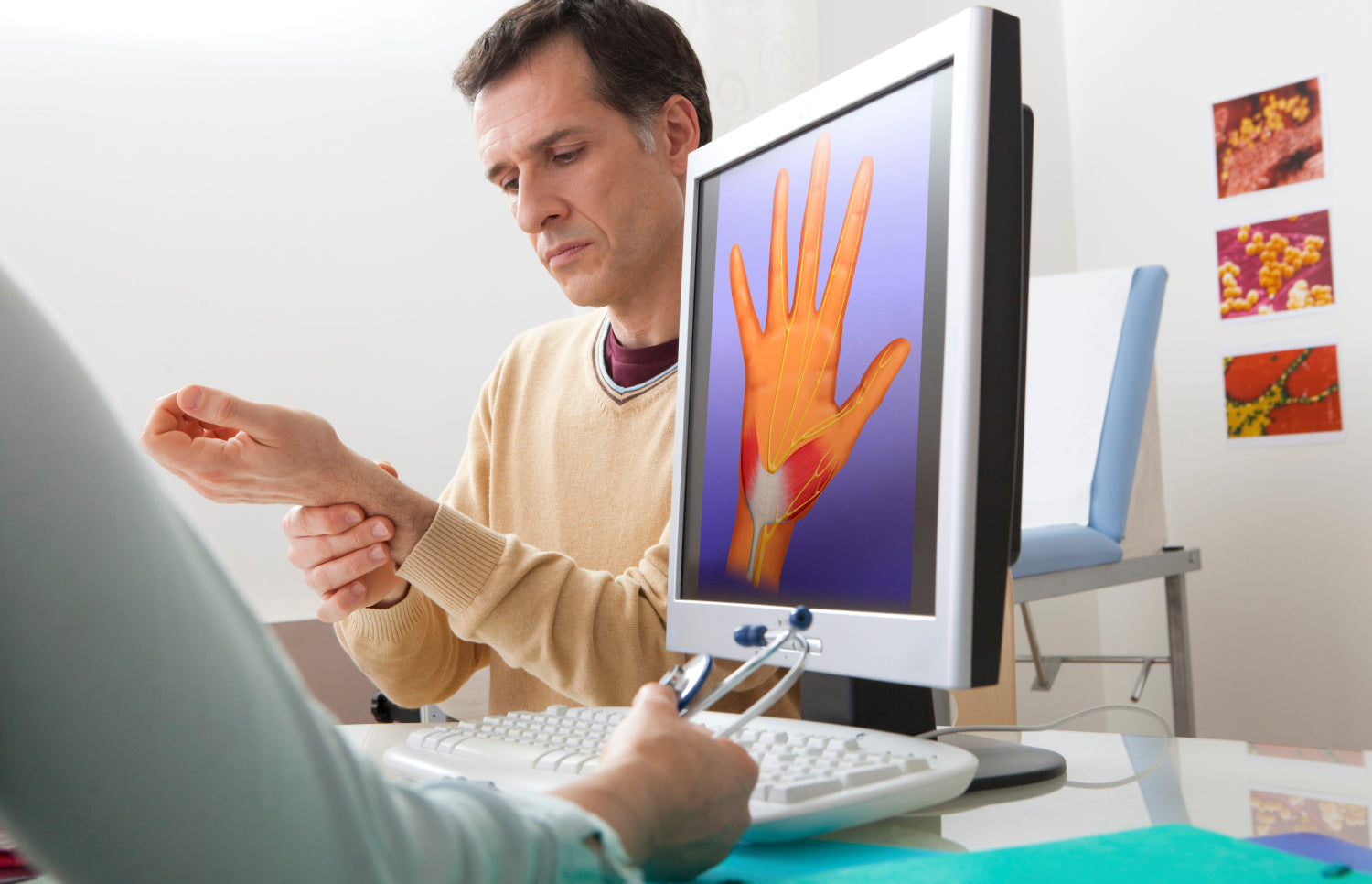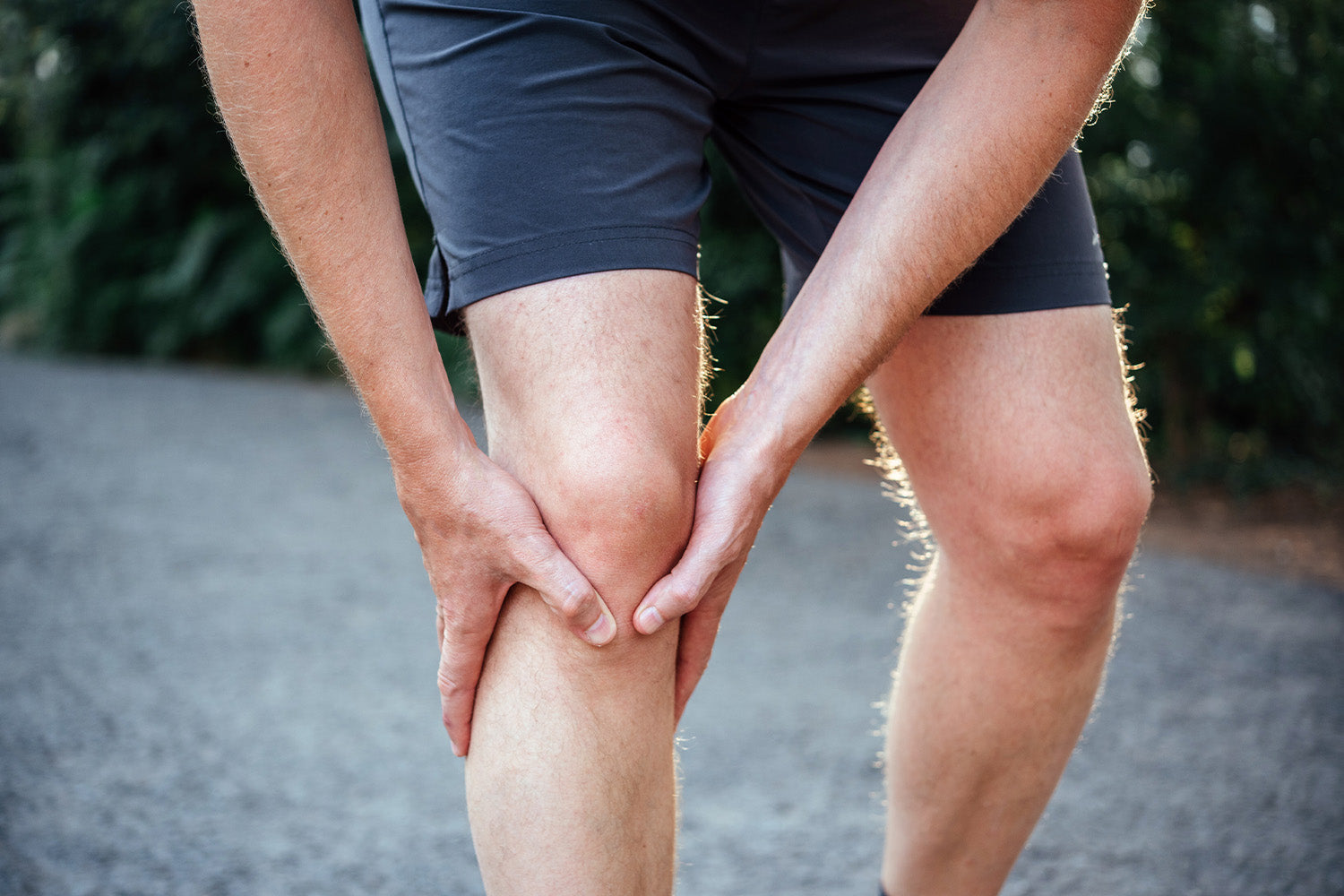Medically Reviewed By | Johannah Gregg, DNP FNP-C
If you’ve noticed pain and stiffness near one of your joints, it may be due to a condition called bursitis. In this article, we’re breaking down everything you need to know about bursitis — what it is and ways you can treat it.
What Is Bursitis?
Throughout your body, there are small fluid-filled sacs called bursae (plural of “bursa”) that provide cushioning where bones come into contact with other tissues, like muscles, tendons, and skin. A bursa protects against unwanted friction and rubbing between these tissues, which would cause inflammation without it.
Bursitis is an uncomfortable and painful condition in which one of these sacs swells up due to irritation. Even though bursae exist in all different areas of the body, this condition mostly causes inflammation of the bursae near joints.
Bursitis may come on quickly or develop over a longer period.
Where Can Bursitis Happen?
Although bursitis can occur in any bursa, here are the most common forms of bursitis and where they happen:
Retromalleolar Tendon Bursitis
The Achilles tendon attaches the calf muscles to the back of the heel. Retromalleolar tendon bursitis happens when the bursa near this tendon becomes inflamed.
Posterior Achilles Tendon Bursitis
Another bursa in the heel area sits between the skin and the Achilles tendon. This type of bursitis happens when this bursa is aggravated.
Hip Bursitis
Also known as trochanteric bursitis, a bursa near the hip bone is affected. This specific form of bursitis is more common in women and those who are older.
Certified Family Nurse Practioner Johannah Gregg notes that she’s seen it commonly with sprinters, cyclers, and hurdlers along with high-impact athletes.
Elbow Bursitis
The bursa between the skin and the elbow bones is prone to becoming inflamed due to injury or repetitive pressure such as leaning on elbows while working on the computer.
Knee Bursitis
There is a bursa on the inside of the knee, between the shin bone and hamstring muscles — it can swell for several reasons, including a lack of stretching before physical activity.
Kneecap Bursitis
The bursa between the skin and the bone of the kneecap is prone to becoming inflamed, especially for those kneeling on their knees often such as gardeners or house cleaners.
Shoulder Bursitis
Also called subacromial bursitis, inflamed bursae in the shoulder, between the rotator cuff and shoulder blade, is very common.
Ischial Bursitis
This type of bursitis occurs in the bursae near the gluteus maximus muscles. Pain while sitting might be an indication of this condition.
Who Is Most at Risk for Bursitis?
Bursitis can happen to anybody, but there are a few factors that increase your risk of developing an inflamed bursa, including:
- If you are older.
- If you have a Job that requires a lot of repetitive movements or leaning on bones for extended periods. For example, plumbers or carpet layers spend a lot of time working from their knees.
- If you are an athlete who makes a lot of repetitive motions. For example, tennis players from serving and baseball players pitching.
- If you suffer from conditions such as arthritis, diabetes, gout, or thyroid disease.
Causes of Bursitis
The main culprit of bursitis are persistent, repetitive motions — think of a tennis player hitting the ball in the same way over and over, day after day. Putting a lot of pressure on certain areas of the body can also cause bursitis — think of a carpet layer constantly kneeling to install carpeting.
It’s less likely, but injuries and infections can cause an inflamed bursa.
Activities that are particularly high risk for bursitis are:
- Gardening, landscaping, and raking.
- Carpentry and painting.
- A misaligned bone or joint.
- Poor posture.
- Shoveling and scrubbing.
- Tennis, baseball, and golf.
What Are the Symptoms of Bursitis?
Most of the time, bursitis symptoms pop up around muscles, joints, and bones. You may feel a degree of joint pain, especially when moving the affected area, the affected joint may have a limited range of motion, and you may notice some swelling in the surrounding soft tissue.
Bursitis can also be accompanied by redness, warmth, fever, and chills if it results from an infection.
How Do I Know if I Have Bursitis?
Bursitis can be confused with other conditions that affect joints, such as tendonitis and rheumatoid arthritis. To know that you are dealing with a swollen bursa, you should talk to your healthcare provider for professional medical advice. They will probably be able to diagnose you based on a physical exam.
Inflammation of a bursa can be recurring in some cases. If this happens or it is suspected that you may have an infection, your provider will probably order certain tests to get a better look at your body.
These include:
- X-rays to rule out any other conditions.
- MRIs (magnetic resonance imaging), ultrasounds, and other imaging tests may be used to detect problematic bursae.
- Blood tests to detect infections.
- Taking a sample from the affected bursa.
Your primary care provider will also ask questions about your medical history and current medical conditions to try and identify the cause of your discomfort.
How Is Bursitis Treated?
The main method of treating bursitis is simply resting the affected area for enough time so that it can heal and repair. Depending on your medical history, your doctor may recommend over-the-counter nonsteroidal anti-inflammatory drugs (NSAIDs) like ibuprofen to manage your pain.
Dr. Gregg notes that compression wraps can also help prevent the swelling from increasing.
In extreme cases, your doctor may prescribe steroid injections to speed healing or splints to immobilize the bursa while it heals.
It is especially important to stop whatever specific action causes bursitis. If you are a golfer, take time off from swinging your clubs. If you are a plumber, don’t put any pressure on your knees for a while.
When To Seek Medical Treatment
Most bursitis cases do not need medical attention; they will go away independently with rest. However, you should take to a healthcare provider if:
- The pain is so bad that it’s interfering with your daily activities.
- The soreness does not improve with time and self-care measures.
- Bursitis in a particular area happens more than once.
- The bursitis is accompanied by fever.
- There is redness or warmth in the area of the bursitis
Bursitis Prevention
Because most inflamed bursae are caused by overuse, it is fairly simple to prevent them. Avoiding or changing the motion that is putting you at risk is most important, along with:
- Implementing proper posture and techniques for your sport or occupation.
- Avoiding sitting and kneeling for long periods. If you must, use cushions and pads.
- Maintaining a healthy weight to keep excess pressure off of joints.
- Take plenty of breaks when you are doing tasks that involve repetitive motions.
- Making sure to warm up before physical activity and cool down to lower the risk of injury.
- Avoid repetitive tasks, or find ways to switch up muscle movements to avoid risk factors for bursitis.
What Else Can You Do About Bursitis?
Other possible treatments for bursitis include:
- Your healthcare provider may prescribe you antibiotics if you have an infection.
- You can receive physical therapy to increase your mobility.
- Participate in occupational therapy to learn how to move for your job.
- The bursa can be injected with corticosteroids to reduce inflammation quickly.
- If an aggravated bursa is persistent and other treatments fail, surgery may be done to repair the tissue.
- Wear a compression wrap over the affected joint to help prevent reoccurrence.
Incrediwear Can Help
One of the best ways to prevent and treat cases of bursitis, no matter where they occur in the body, is to use Incrediwear sleeves and braces before, during, and after physical activity.
Unlike the traditional compression sleeves, Incrediwear uses a special fabric with semiconductors to aid your body’s natural healing process. When the heat from your skin activates the fabric, negative ions are released into the tissues, vibrating cells and increasing blood flow to the area. The oxygen and nutrients that the blood carries accelerate recovery.
Here are a few of the best Incrediwear products that can help prevent and quell bursitis symptoms:
Knee Sleeve
The knee sleeve slides over your foot and covers the area above the knee to the middle of the shin.
Elbow Sleeve
The elbow sleeve slides on your arm and covers from the bicep to the mid-forearm.
Shoulder Brace
The shoulder brace covers from the shoulder blade down to the bicep and is secured by wrapping around the opposite side of the body.
Conclusion
Bursae are small fluid-filled sacs that act as natural cushioning throughout the body, preventing tissues from rubbing against each other too much. They exist around joints, muscles, tendons, and areas prone to friction. A bursa can become aggravated, leading to a painful condition called bursitis.
Athletes and workers who put a lot of stress and strain on specific body parts are particularly at risk of developing inflamed bursae. Persistent, repetitive action appears to be the main culprit, so tennis players, baseball players, and golfers should be on the lookout.
The good news is, there's a lot you can do to avoid and treat bursitis, including using Incrediwear sleeves. It is not a very serious condition and usually resolves with proper rest and time.
Sources:
Arthritis - Symptoms and causes | Mayo Clinic
Read more

Medically Reviewed By | Johannah Gregg, DNP FNP-C Carpal tunnel syndrome is sure to put a damper on your favorite daily activities, but it doesn’t have to. Despite the unfortunate side effects of c...

If you are due to have surgery or have recently undergone an operation, you might start wondering how soon you can jump back into your workout routine. Here are 6 ways to get back after it safely.






Leave a comment
All comments are moderated before being published.
This site is protected by hCaptcha and the hCaptcha Privacy Policy and Terms of Service apply.